
6 Outdoor Winter Running Tips
Leave a CommentWith winter kicking into high gear and limited indoor options for workouts, people are increasing their walking and running outside as forms of new exercise. As you prepare to bundle up and either ramp up your running or start a new hobby, planning the appropriate training plan is key! As a Physical Therapist, this is the time of the year where I often see people get injured from improper running training. Here are just a few tips to keep you running strong all winter long!
1. Begin with the proper footwear.
It is vital to make sure your sneakers are correct for you as you start running this winter. Running sneakers should be changed every 300-500 miles and should be the right type based on your foot shape and movement. For a flat foot that tends to strike inward, a stability shoe will add support and structure to the inner arch. For a more rigid foot or high arch, a neutral shoe offers more cushion in order to absorb shock properly. The team at your local running store can help fit you for a shoe best suited for your needs.
2. Find muscular balance.
So many times, we see runners come in with pain in the beginning of the season. This can be due to a mismatch of strength and flexibility between the muscles on the front side and back side of your lower body. This imbalance can lead to changes in leg positioning and the development of back or foot pain. By strengthening your hip muscles via resistance band exercises along with stretching out the front of your thighs where the quadriceps and hip flexors sit, we take pressure off the knees which aids in proper running form and longevity in the sport. Later in this blog you can find a few exercise examples to assist in strengthening.
3. Build up your volume.
All kinds of injuries can occur ranging from muscle pulls to stress fractures when running more miles than your body can handle. Gradually increase the distance and times a week you run in order to minimize the potential for developing overuse and chronic injuries.
4. Shorten your stride.
Speed up your feet to reduce the length of each stride you take. This will lead to more steps on the ground but less forceful contact to your feet, knees, and hips. Although the number of steps you take are higher, the amount of force exerted from the ground is less than it would be from a longer stride. Over time this leads to less force through your joints and reduces the chance of injury.
5. Warm up and cool down properly.
Spend time foam rolling your thighs and quadriceps muscles or performing a dynamic warm up prior to your run and cool down with some static stretching. This can take as little as five minutes prior to and at the end of the run and can make all the difference!
6. Listen to your body.
Injuries do not magically go away on their own. Seek help when injuries worsen or when pain begins at rest.
Hip Flexor Stretches
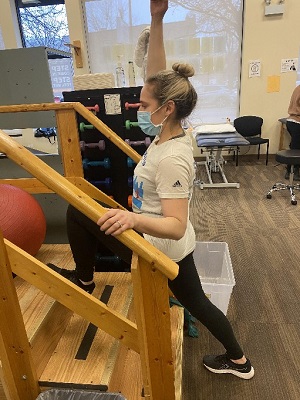
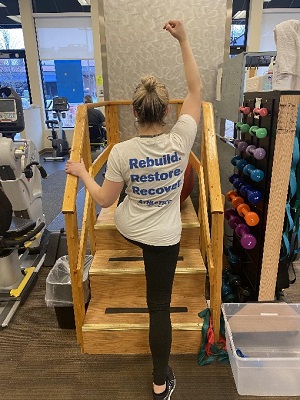
- Bend one knee on an elevated surface while leaning forward at your waist and keeping your back leg straight.
- Squeeze your back-leg buttock and hold.
- Stretch for 3 repetitions for 20-30 seconds each.
- Perform on both sides.
Calf Stretches
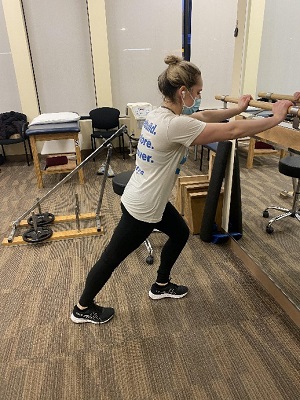
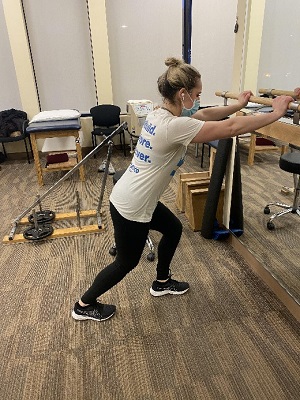
- Perform both of these to stretch the two calf muscles.
- For the Gastrocnemius calf muscle (pictured on the left), stagger your feet and bend the front knee while keeping the back leg straight.
- Lean forward and complete 3 repetitions for 20-30 seconds.
- For the Soleus calf muscle, perform the stretch on the right by standing in the same position but instead of having the back leg straight, bend your knee slightly.
Hamstring Stretch
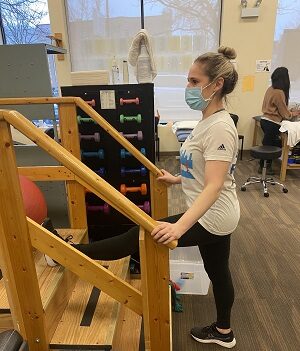
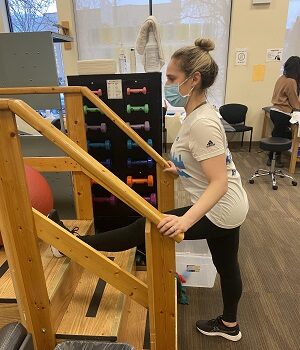
- Perform by lifting one leg to an elevated surface and keep it straight.
- Hinge at your waist until a stretch is felt in the back of your leg.
- Perform stretch for 3 repetitions for 20-30 seconds.
Bridges
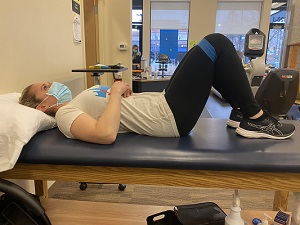
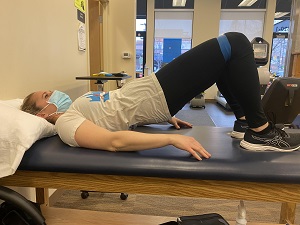
- Lay on your back with your feet separated flat on the table.
- Lift up your hips off the table while keeping your back in a straight position.
- Add a band for extra resistance and try and separate your knees.
- Perform for 3 sets of 10 repetitions.
Clamshells
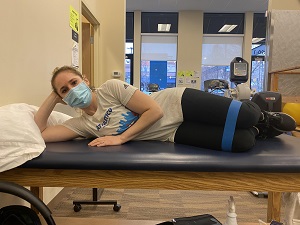
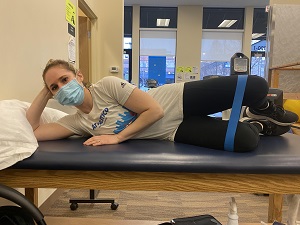
- Lay on your side with your knees bent and forward.
- Attempt to line up your heels with your hips.
- Lift your top knee toward the ceiling while keeping your feet against each other.
- Add a band for additional resistance.
- Perform 3 sets of 10 repetitions.
Lateral Walks
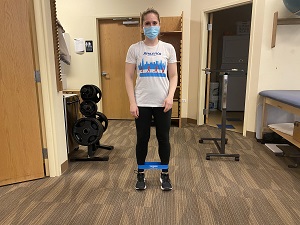
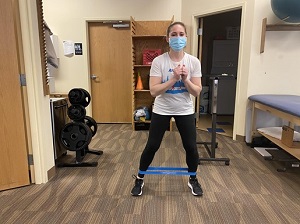
- Stand and place the band around your ankles.
- Create tension in the band by separating your feet.
- Walk in a side step fashion while staying in a slight squat and keeping your feet forward the whole time.
- Step 8 to 10 steps in each directions.
We want to keep you healthy and moving to maintain your running all winter long! Should you experience any aches or pains after your runs, a free assessment by a licensed physical therapist can help provide peace of mind and get your recovery process started before an injury worsens. Free assessments are available in-clinic and online through our telehealth platform.
Physical therapy is usually the thing you are told to do after medication, x-rays or surgery. The best way to fix your pain is to start where you normally finish – with physical therapy at Athletico.
The Athletico blog is an educational resource written by Athletico employees. Athletico bloggers are licensed professionals who abide by the code of ethics outlined by their respective professional associations. The content published in blog posts represents the opinion of the individual author based on their expertise and experience. The content provided in this blog is for informational purposes only, does not constitute medical advice and should not be relied on for making personal health decisions.
